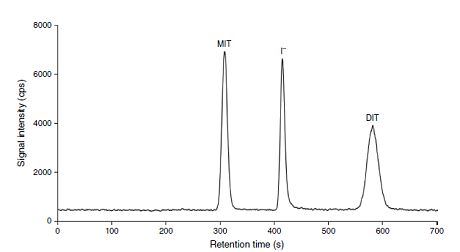Researchers from the National Food Institute in Denmark have optimized the extraction procedure and chromatographic separation of iodine species found in seaweed. Using the optimized method, they studied the iodine speciation in different types of seaweed samples.
Background: Iodine is an essential element required for human health and metabolism. Iodine is involved in the synthesis of thyroid hormones, regulating the energy metabolism and development of organs. Deficiency of iodine is a health thread for nearly 3% of the population and is combated by supplementation, mostly by adding iodine to table salt.
In recent years, an increased focus on the use of seaweed, i.e. marine macroalgae, for food and feed applications has been seen. Since certain types of seaweed may contain high levels of iodine, the possibility to use seaweed as an iodine source has been discussed. Yet, also food safety concerns have been raised, since the iodine content between seaweed species is quite variable with iodine levels between 100 and 10 000 mg/kg.
To make the situation even more complex, several iodine-containing chemical species have been identified in seaweed. These species differ in toxicity and bioavailability, with the inorganic forms being less toxic and more bioavailable compared to the organic forms. Different seaweed species not only differ with respect to their iodine concentration level but also in their speciation. However, the occurrence and identity of the individual species are still not fully elucidated. Such lack of information calls for the development of sensitive and selective iodine speciation methods.
The new study:Researchers from Denmark have now addressed the problem by developing a method for the determination of iodine species in seaweed samples meant for human consumption. Especial attention during the development was paid to the optimization of the extraction procedure and the separation of species by high performance liquid chromatography (HPLC) coupled with inductively coupled plasma–mass spectrometry (ICP-MS). In order to obtain a high extraction efficiency without compromising species integrity, extraction was conducted in two steps. The first step was consisting of pancreatic enzymatic extraction followed by alkaline extraction with tetramethylammonium hydroxide at 90°C for 3h. When cooled, samples were diluted, centrifuged and diluted if necessary. The diluted samples were filtered prior to LC-ICP-MS analysis.
Species separation was obtained on an IonPac AG 20 analytical column (2 x 250 mm) with a AG 20 guard column (2 x50 mm). Chromatographic conditions were optimized and finally elution of the species was done isocratically with a mobile phase of 400 mM NH3HCO3 with a flow rate 0f 0.25 ml/min. Under these conditions, the three main iodine species observed in seaweed, namely monoiodotyrosine (MIT), diiodotyrosine (DIT) and iodide were nicely separated within chromatographic runs of less than 12 min.

Figure 1: Chromatogram showing the separation of three iodine species (each 5 µg/L) under optimized conditions.
Total iodine was determined by ICP-MS after alkaline extraction with TMAH in an oven at 90°C for 3 h.
The optimized procedure was used for the analysis of a range of different seaweed types from all three seaweed groups, namely brown (6 samples), red (6 samples) and green (3 samples). The total iodine in these samples ranged from 33 to 5611 µg/g, with the highest content observed in the brown sugar kelp. Inorganic iodine was the most abundant species in all samples making between 64.8 and 100% of the sum of species. MIT and DIT were present in different concentrations in most of the samples. These species showed the highest concentration in red seaweeds, while their concentration was low in brown seaweeds. Altogether, 6 unknown species were observed, constituting up to 9.8% of the determined species concentration.
The authors expressed their hope that their method will be a valuable tool in future studies related to the iodine speciation and their biotransformation in marine algae.
 The original publication
The original publication

Ana Jerše, Heidi Amlund, Susan L. Holdt,
Jens J. Sloth,
Speciation analysis of iodine in seaweed: optimisation of extraction procedure and chromatographic separation, Environ. Chem., 20/1&2 (2023) 95–104.
DOI: 10.1071/EN22133
 Related Studies:
Related Studies:

A. Jerše, D. Kutscher, C. Fischer,
J.J. Sloth, Determination of iodine- containing species in seaweed using IC-ICP-MS. Thermo Scientific Application note 44475 (2020). Available at
https://assets.thermofisher.com/TFS-Assets/CMD/Application-Notes/an-44475-ic-icp-ms-iodine-seaweed-species-an44475-en.pdf
V. Romarís-Hortas,
P. Bermejo-Barrera, A. Moreda-Piñeiro,
Ultrasound-assisted enzymatic hydrolysis for iodinated amino acid extraction from edible seaweed before reversed-phase high performance liquid chromatography-inductively coupled plasma-mass spectrometry. J. Chromatogr. A, 1309 (2013) 33–40.
DOI: 10.1016/j.chroma.2013.08.022
V. Romarís-Hortas,
P. Bermejo-Barrera, A. Moreda-Piñeiro,
Development of anion-exchange/reversed-phase high performance liquid chromatography-inductively coupled plasma-mass spectrometry methods for the speciation of bio-available iodine and bromine from edible seaweed. J. Chromatogr. A, 1236 (2012) 164–176.
DOI: 10.1016/j.chroma.2012.03.019
X. Han, L.H. Cao, H.Y. Cheng, J.H. Liu, Z.G. Xu,
Determination of iodine species in seaweed and seawater samples using ion-pair reversed phase high performance liquid chromatography coupled with inductively coupled plasma mass spectrometry. Anal. Methods, 4 (2012) 3471–3477.
DOI:10.1039/C2AY25871D
V. Gómez-Jacinto, A. Arias-Borrego, T. García-Barrera, I. Garbayo, C. Vílchez,
J.L. Gómez-Ariza,
Iodine speciation in iodine-enriched microalgae Chlorella vulgaris. Pure Appl. Chem., 82 (2010) 473–481.
DOI: 10.1351/PAC-CON-09-08-01
M. Shah,
R.G. Wuilloud, S.S. Kannamkumarath, J.A. Caruso,
Iodine speciation studies in commercially available seaweed by coupling different chromatographic techniques with UV and ICP-MS detection. J. Anal. At. Spectrom., 20 (2005) 176–182.
DOI: 10.1039/B415756G
last time modified: September 18, 2024